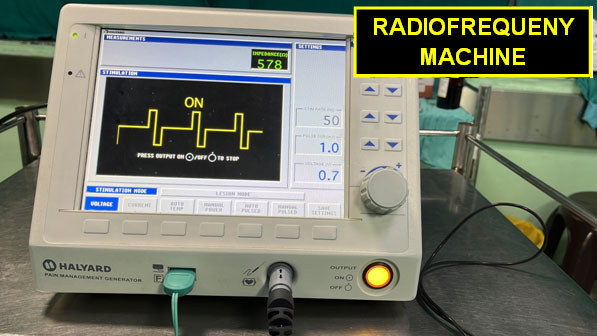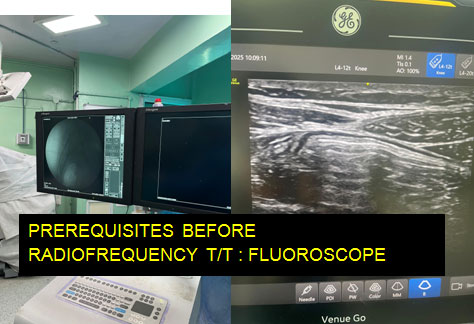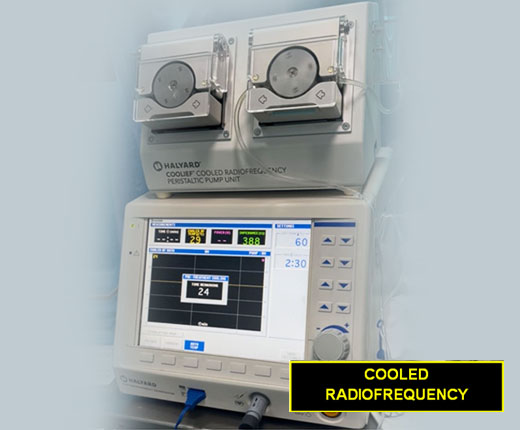History of radiofrequency treatment for pain
Radiofrequency ablation for pain was first documented in the 1930s. In the latter part of the 20th century, treatment started for the management of facet joint related back and neck pain. In addition to changes in equipment and techniques, it has also evolved to provide relief for various pain conditions in modern day practice like genicular nerve radiofrequency for knee arthritis pain.

Prerequisites before performing radiofrequency procedure
- clinical area with trained professionals and equipment
- consent of patient
- i/v cannula
- minimal sedation
- monitoring – pulse, BP, ECG, SpO2
- local anesthetic infiltration near entry site for RF cannula
- Fluoroscopy or ultrasound to confirm needle positions

Goals of radiofrequency
- improvement in pain
- improvement in function and quality of life
- reduce the need for analgesics
- avoid or delay surgery
Why We Are Different

No
Surgery

30-Minute Procedure

Targets Root Cause

Minimal Downtime

Long-Lasting Results

Proven, Safe Methods
What pain conditions can be treated with radiofrequency
- Back pain – especially spondylosis , facet pain, sacroiliac joint pain, sciatica, disc pain, tailbone pain
- Neck pain – cervical spondylosis, neck pain radiating to arm
- Knee pain – arthritis of knee, post knee replacement pain
- Shoulder pain – resistant shoulder pain due to severe arthritis or rotator cuff injury
- Face pain – caused by trigeminal nerve or its branches like trigeminal neuralgia
- Peripheral nerve pain – nerve entrapment, post surgical pain
- Cancer pain – like pancreas cancer pain, uterine cancer pain, mouth cancer pain, intestine cancer pain
Who should get radiofrequency treatment
Longstanding pain that does not respond to medication and/or physiotherapy
Recurrent pain following a nerve block or epidural injection
Who is not an ideal candidate for radiofrequency treatment for pain
- Pregnant patient
- Bleeding disorder
- Infection near the target nerve
How long does it take to get radiofrequency treatment at Dr Ekta’s Pain management clinic
It may take from 15 min to 90 min depending upon location of nerve and number of nerves being treated
Treatment details of radiofrequency treatment of spine in low back pain
Within the spine,nerves branch off the spinal cord and reach the joints and muscles of the spine for ega) medial branch nerve reaches the facet joint (small joints between vertebra of spine) – target for RF ablation
lateral branch nerve reaches the sacroiliac joint (joint that connects your spine to the pelvis and hip) – target for RF ablation
nerve roots forming sciatic nerve L3, L4, L5, S1 causing leg pain despite no inflammation – target for neuromodulation
These are the most common pain generators in a patient of low back pain.
Steps of treatment:
- You will lie on your stomach on the special table in the procedure room/operating room
you will be awake throughout the procedure and can talk to doctor. Only small amount of anxiolytic is given. Procedure is virtually painless especially after injecting local anaesthetic near the intended nerve area.
- A special thin needle (RF cannula) is inserted near the area you feel pain. This needle is guided to exact area of pain and nerve using continuous X ray or ultrasound
- A radiofrequency current is sent through the needle to heat the identified nerve segment
- The current partially destroys that area of nerve making it incapable of sending pain signals to brain
- Multiple nerves (according to diagnosis) can be targeted in a single sitting
Treatment details of radiofrequency treatment of knee
Knee joint has a complex nerve supply from 10-12 very small nerves. These are called genicular nerves of knee joint. Many of these can be targeted through RF ablation without affecting strength and sensation of knee joint but providing effective pain relief.
Steps of treatment
- You will lie on your back on the special table in the procedure room/operating room
you will be awake throughout the procedure and can talk to doctor. Only small amount of anxiolytic is given. Procedure is virtually painless especially after injecting local anaesthetic near the intended nerve areas.
- A special thin needle (RF cannula) is inserted near each of the genicular nerves of knee joint. This needle is guided to exact area of nerve using continuous X ray or ultrasound.
- A radiofrequency current is sent through the needle to heat the identified nerve segment
- The current partially destroys that area of nerve making it incapable of sending pain signals to brain
- Multiple such nerves (usually 3-5 major genicular nerves) are targeted in a single sitting
What care should be done after radiofrequency treatment
- You should get back home after an hour of rest at the treatment area accompanied by a friend/family
- Avoid strenuous activity for 24 hrs after the procedure. You can get back to work next day in most cases.
- Apply ice off and on for 20 minutes at site of procedure especially if you feel pain/soreness for first 3-4 days.
- Begin stretching and strengthening exercises as explained by treating team after 1 week. Check progress at follow up appointment
What are the advantages of radiofrequency treatment for various joint pains, back pain, nerve pain etc
- Pain relief
- No surgery
- Very little downtime
- Early return to regular activities
- Rehabilitation at home
- Hospital stay not essential
What are the side effects/risks of radiofrequency treatment of back pain knee pain
You may experience some pain, numbness, stiffness for 2-5 days. This settles down as the effect of RF treatment sets in.
The risk of complication is actually very low mainly because needle is always guided under x ray / ultrasound image. Only in rare circumstances, permanent nerve damage or worsening of pain may be reported. Other complications like infection and bleeding are also uncommon.
How effective is RF treatment for joint pain and spine pain ?
RF treatment whether ablation or neuromodulation does bring some pain relief in most patients depending on location and severity of disease.
Pain relief after RF treatment is generally immediate but can take upto 2-3 weeks to be fully effective.
Pain relief after RF treatment will generally last 6months- 2years. Some patients may have longer pain relief lasting many years especially trigeminal neuralgia pain. The treated nerve can regrow after 6months-12 months. If this is the case, RF procedure can be repeated with same efficacy.
Radiofrequency Ablation FAQs
How fast will the RFA provide relief?
Often, 1 to 2 weeks after RFA, when the nerve terminus stops transmitting pain signals fully, some relief may be experienced.
RFA: How long will its effect last?
Pain relief typically lasts 6 to 18 months, depending on the patient and the condition.
Is RFA painful?
Most patients feel slight discomfort from the local anesthesia during the procedure.
Can you repeat this procedure?
Yes, if the nerves are regenerated, and the pain returns, this procedure can be repeated.
RFA is contraindicated in whom?
Patients suffering from bleeding disorders, with ongoing infections, or with some uncontrolled health issues might be unsuitable candidates.
Why Choose Dr Ekta's Pain Management Clinic for RFA?
- Experienced Pain Specialists trained in advanced interventional procedures.
- State-of-the-Art Imaging Guidance for safe, precise targeting of nerves.
- Personalized Care programs/plans tailored to each patient’s condition and goals.
- Holistic Pain Management combining RFA with physiotherapy, exercise, and lifestyle guidance.
- Patient-First Approach ensuring comfort, compassion, and long-term relief.
At Dr Ekta's Pain Management Clinic, we focus on restoring healthy lives and improving the quality for chronic pain patients. Radiofrequency Ablation (RFA) offers a state-of-the-art, minimally invasive treatment that will assist you with moving around, working, and living free from the encompassing burden of pain.
Why Choose Us
We’re the most trusted Pain Specialists in West Delhi.
Backed by the new findings from global pain management clinical research and data, our targeted and evidence-based non-surgical pain treatment therapies such as medication management, physiotherapy, nerve blocks, and regenerative treatments, precisely aims to provide immediate and lasting pain relief without the need for a surgery.
In pursuit of helping our patients live an active and fulfilling life, our pain specialists in West Delhi at our specialized pain management clinic, performs expert diagnosis and evaluations to identify the root cause of pain and focus on restoring mobility for improved quality of life.
Here’s why we’re the best at what we do:
- Expertise
- Compassionate Care
- Advanced Techniques
- Personalized Treatment Plans
- Commitment to Quality
- Transparent
 info@drektapainmanagement.com
info@drektapainmanagement.com +91-9560852171
+91-9560852171 E 29/b, Rajouri Garden, New Delhi, 110027
E 29/b, Rajouri Garden, New Delhi, 110027


